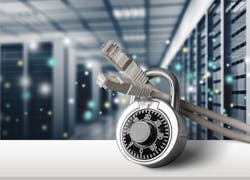Securing control systems is paramount in our interconnected world. Safeguarding critical infrastructure from cyber threats is vital to avert disruptions and ensure the continuous operation of essential systems. Attacks by hackers and control-system attacks can have a harmful effect on vital services.
Control systems are susceptible to outdated software, weak authentication and absent encryption. These gaps expose systems to cyber threats, aiding unauthorized access and critical infrastructure compromise. Incidents like the Stuxnet worm hitting Iranian nuclear sites and the Ukrainian power grid cyberattack underscore the dire consequences of breached control systems.
A multi-layered security strategy for control systems involves the installation of many security measures, such as firewalls, access limits, intrusion detection systems and regular upgrades to give full safeguards against possible breaches. Network security, access controls and physical security work together to create a robust defense for control systems. Network security protects against cyber threats; access controls restrict unauthorized access; and physical security safeguards against physical tampering or sabotage.
Securing control-system networks entails techniques like air-gapping for critical system isolation, network segmentation based on function and firewall use to filter and track traffic. Vigilantly monitoring network activity is vital for spotting and thwarting security breaches. Rapidly identifying anomalies and unauthorized access empowers organizations to promptly counter risks and fortify their systems.
Robust access controls and authentication are vital for safeguarding sensitive data and systems. Techniques like multi-factor authentication and role-based access control ensure only authorized users access critical resources, reducing risks of breaches. Role-based access control assigns permissions based on user roles. Two-factor authentication improves security by demanding two kinds of authentication, such as a password and a cellphone code. Effective control enforcement with minimal disruption involves regular permission reviews, educating staff, monitoring access logs and automated access management.
Maintaining up-to-date control system software is vital for peak security. Regular updates patch vulnerabilities, minimizing unauthorized access risks. Updates can be tricky due to compatibility and disruptions. To handle patches well, focus on vital updates, test thoroughly and prepare rollback plans. Outdated software risks include vulnerabilities, compatibility problems and limited functions. Staying current offers better security, performance, new features and tech compatibility.
Employees are pivotal in upholding control-system security. They follow protocols, stay vigilant for anomalies and report concerns promptly. Invaluable ongoing training educates employees on best practices, enhancing their ability to spot and counter risks, bolstering security. Threats like phishing, malware and social engineering require cautiousness. Employees should scrutinize emails, update antivirus software and report oddities to IT or security teams.
A well-defined incident response strategy is critical for companies to address security problems quickly and promptly. It assists in minimizing damage, reducing downtime and ensuring a quick recovery, ultimately protecting the organization's reputation and consumer confidence.
A well-defined incident-response plan mitigates the impact of a security breach by providing precise instructions on how to restrict the intrusion, mitigate its effects and restore systems and data as soon as possible. It aids in limiting the spread of the breach and decreases the risk of future injury.
To guarantee its success, an effective incident response plan should include critical features such as clear roles and duties, a defined chain of command, communication protocols, event detection and reporting methods, and frequent testing and updates.
Fostering a security culture inside an organization is critical because it improves awareness, promotes best practices and encourages workers to prioritize security, lowering the chance of breaches and encouraging a proactive approach to cybersecurity. Collaboration between departments, from information technology to operations, improves overall control-system security by allowing information exchange, assuring uniform security procedures and enabling a coordinated reaction to possible threats and vulnerabilities.
Continuous monitoring of control-system security is critical for discovering and mitigating potential vulnerabilities, detecting unauthorized access or irregularities and guaranteeing critical system and data integrity, availability and confidentiality. Regular security evaluations and audits give significant insights into the efficacy of control-system security measures, uncover potential flaws and enable proactive risk reduction and security posture enhancement. Security improvement and adaptation are ongoing processes that require continuous evaluation, analysis and adjustment. By iterating and refining security measures, organizations can stay ahead of evolving threats and ensure robust protection.
Significant advantages stem from the consistent undertaking of security assessments and audits. These practices stand as integral components in the organizational pursuit of identifying vulnerabilities and subsequently elevating the comprehensive security landscape. A pivotal point underscored is the recurring and evolving nature of security enhancement and adjustment. The realm of control-system security is a domain that necessitates unwavering watchfulness and a cohesive organizational partnership.
Control-system security thrives on perpetual vigilance, not isolated efforts but a continuous initiative. Proactive monitoring intercepts potential threats before they mature. Regular training equips the workforce to counter emerging threats. Control-system security is an ongoing journey, with assessments guiding improvements. The dynamic nature requires continual adaptation through monitoring, training and a security-focused culture.
About the Author
Shawn Cox
Contributing Editor
Shawn Cox is a licensed master electrician/PLC programmer. He was co-owner/operator of Bobby Cox Electric for 15 years and is currently employed by BMW Manufacturing as an ESA. Contact him at [email protected].

Leaders relevant to this article:

